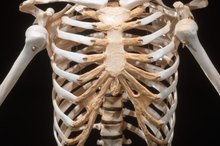How the Skeletal System Works With Other Systems in Your Body
Protection
According to Minnesota State University's Emuseum, one of the most important ways the skeletal system works with other systems is via protection. Of particular importance is the skeletal system's ability to protect the central nervous system, which is made up of the spinal cord and the brain. The skeletal system surrounds these organs and safeguards delicate nerve tissue from trauma. The skeletal system also protects the heart and lungs in the chest via the ribs.
- According to Minnesota State University's Emuseum, one of the most important ways the skeletal system works with other systems is via protection.
- Of particular importance is the skeletal system's ability to protect the central nervous system, which is made up of the spinal cord and the brain.
Muscular System
Vacutainer Advantages & Disadvantages
Learn More
The interaction between the skeletal system and the muscular system is so constant that sometimes the two organ systems are referred to as one system--the musculoskeletal system. Skeletal muscles must be attached to something at either end to give them support while they contract. Typically this means each end of a skeletal muscle is attached to a bone. According to Hillendale Health, when a muscle contracts, it brings the two bones closer together. Skeletal muscles are connected to bones via bands of connective tissue called tendons. If a tendon is severed, the muscle no longer has anything to contract against and becomes essentially useless.
- The interaction between the skeletal system and the muscular system is so constant that sometimes the two organ systems are referred to as one system--the musculoskeletal system.
- Skeletal muscles must be attached to something at either end to give them support while they contract.
Hematological System
The skeletal system is important to the composition of the blood, notes Minnesota State University's Emusuem. Inside the bones is a substance called bone marrow. Bone marrow is responsible for making new blood cells. Red blood cells are needed for the transport of oxygen throughout the body. White blood cells play a critical role in the immune system. Because the bone marrow is the area where these cells are made, problems with the skeletal system can have a huge effect on the hematological system (the blood).
- The skeletal system is important to the composition of the blood, notes Minnesota State University's Emusuem.
- Red blood cells are needed for the transport of oxygen throughout the body.
Calcium Homeostasis
How the Skeletal System Works With the Muscular
Learn More
McGraw-Hill notes that the skeletal system also plays an important role in the body's regulation of calcium. Calcium levels in the blood have to stay within a very narrow range for muscles and nerves to work correctly. The skeletal system serves as the biggest reservoir for calcium in the body, which allows the body to get extra calcium when blood levels are low and to deposit excess calcium if too much winds up in the blood. The thyroid and parathyroid glands secrete hormones that tell cells within the bones (osteoclasts and osteoblasts) if calcium needs to be released or stored in the bones.
- McGraw-Hill notes that the skeletal system also plays an important role in the body's regulation of calcium.
- The thyroid and parathyroid glands secrete hormones that tell cells within the bones (osteoclasts and osteoblasts) if calcium needs to be released or stored in the bones.
Related Articles
References
- McGraw-Hill: Calcium Homeostasis
- Prepare for a Diagnostic X-Ray. UCSF Radiology.
- ACR-SPR Practice Parameter for the Performance and Interpretation of Skeletal Surveys in Children. American College of Radiology.
- Kim JR, Yoon HM, Jung AY, Cho YA, Seo JJ, Lee JS. Comparison of whole-body MRI, bone scan, and radiographic skeletal survey for lesion detection and risk stratification of Langerhans Cell Histiocytosis. Scientific Reports. 2019;9(1). doi:10.1038/s41598-018-36501-1
- Rajkumar, S. Vincent, Clinical Features, Laboratory Manifestations, and Diagnosis of multiple myeloma. UpToDate.
Writer Bio
Adam Cloe has been published in various scientific journals, including the "Journal of Biochemistry." He is currently a pathology resident at the University of Chicago. Cloe holds a Bachelor of Arts in biochemistry from Boston University, a M.D. from the University of Chicago and a Ph.D. in pathology from the University of Chicago.









